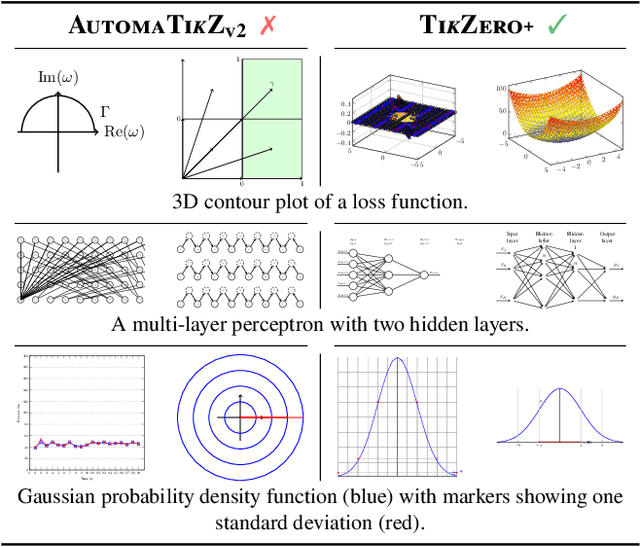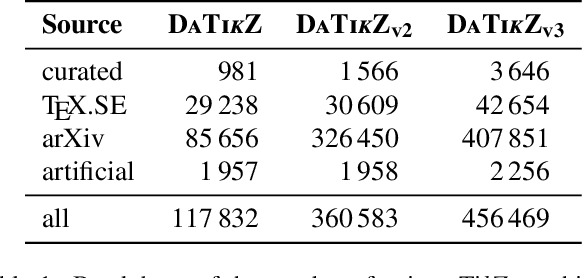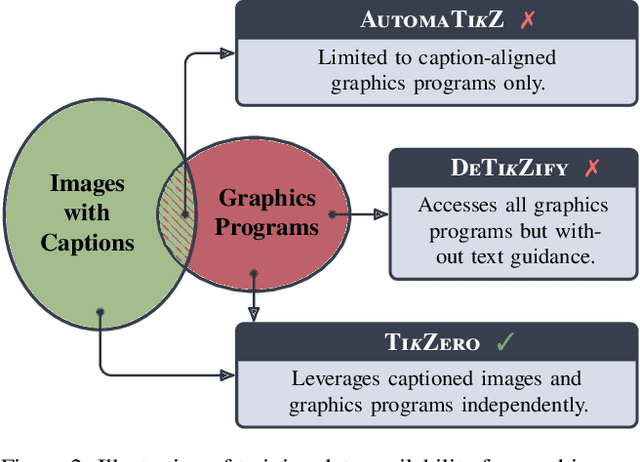Hideki Tanaka
TikZero: Zero-Shot Text-Guided Graphics Program Synthesis
Mar 14, 2025



Abstract:With the rise of generative AI, synthesizing figures from text captions becomes a compelling application. However, achieving high geometric precision and editability requires representing figures as graphics programs in languages like TikZ, and aligned training data (i.e., graphics programs with captions) remains scarce. Meanwhile, large amounts of unaligned graphics programs and captioned raster images are more readily available. We reconcile these disparate data sources by presenting TikZero, which decouples graphics program generation from text understanding by using image representations as an intermediary bridge. It enables independent training on graphics programs and captioned images and allows for zero-shot text-guided graphics program synthesis during inference. We show that our method substantially outperforms baselines that can only operate with caption-aligned graphics programs. Furthermore, when leveraging caption-aligned graphics programs as a complementary training signal, TikZero matches or exceeds the performance of much larger models, including commercial systems like GPT-4o. Our code, datasets, and select models are publicly available.
IteRABRe: Iterative Recovery-Aided Block Reduction
Mar 08, 2025Abstract:Large Language Models (LLMs) have grown increasingly expensive to deploy, driving the need for effective model compression techniques. While block pruning offers a straightforward approach to reducing model size, existing methods often struggle to maintain performance or require substantial computational resources for recovery. We present IteRABRe, a simple yet effective iterative pruning method that achieves superior compression results while requiring minimal computational resources. Using only 2.5M tokens for recovery, our method outperforms baseline approaches by ~3% on average when compressing the Llama3.1-8B and Qwen2.5-7B models. IteRABRe demonstrates particular strength in the preservation of linguistic capabilities, showing an improvement 5% over the baselines in language-related tasks. Our analysis reveals distinct pruning characteristics between these models, while also demonstrating preservation of multilingual capabilities.
Registering Source Tokens to Target Language Spaces in Multilingual Neural Machine Translation
Jan 06, 2025



Abstract:The multilingual neural machine translation (MNMT) enables arbitrary translations across multiple languages by training a model with limited parameters using parallel data only. However, the performance of such MNMT models still lags behind that of large language models (LLMs), limiting their practicality. In this work, we address this limitation by introducing registering to achieve the new state-of-the-art of decoder-only MNMT models. Specifically, we insert a set of artificial tokens specifying the target language, called registers, into the input sequence between the source and target tokens. By modifying the attention mask, the target token generation only pays attention to the activation of registers, representing the source tokens in the target language space. Experiments on EC-40, a large-scale benchmark, show that our method outperforms related methods driven by optimizing multilingual representations. We further scale up and collect 9.3 billion sentence pairs across 24 languages from public datasets to pre-train two models, namely MITRE (multilingual translation with registers). One of them, MITRE-913M, outperforms NLLB-3.3B, achieves comparable performance with commercial LLMs, and shows strong adaptability in fine-tuning. Finally, we open-source our models to facilitate further research and development in MNMT: https://github.com/zhiqu22/mitre.
Improving Language Transfer Capability of Decoder-only Architecture in Multilingual Neural Machine Translation
Dec 03, 2024



Abstract:Existing multilingual neural machine translation (MNMT) approaches mainly focus on improving models with the encoder-decoder architecture to translate multiple languages. However, decoder-only architecture has been explored less in MNMT due to its underperformance when trained on parallel data solely. In this work, we attribute the issue of the decoder-only architecture to its lack of language transfer capability. Specifically, the decoder-only architecture is insufficient in encoding source tokens with the target language features. We propose dividing the decoding process into two stages so that target tokens are explicitly excluded in the first stage to implicitly boost the transfer capability across languages. Additionally, we impose contrastive learning on translation instructions, resulting in improved performance in zero-shot translation. We conduct experiments on TED-19 and OPUS-100 datasets, considering both training from scratch and fine-tuning scenarios. Experimental results show that, compared to the encoder-decoder architecture, our methods not only perform competitively in supervised translations but also achieve improvements of up to 3.39 BLEU, 6.99 chrF++, 3.22 BERTScore, and 4.81 COMET in zero-shot translations.
Centroid-Based Efficient Minimum Bayes Risk Decoding
Feb 17, 2024Abstract:Minimum Bayes risk (MBR) decoding achieved state-of-the-art translation performance by using COMET, a neural metric that has a high correlation with human evaluation. However, MBR decoding requires quadratic time since it computes the expected score between a translation hypothesis and all reference translations. We propose centroid-based MBR (CBMBR) decoding to improve the speed of MBR decoding. Our method clusters the reference translations in the feature space, and then calculates the score using the centroids of each cluster. The experimental results show that our CBMBR not only improved the decoding speed of the expected score calculation 6.9 times, but also outperformed vanilla MBR decoding in translation quality by up to 0.5 COMET in the WMT'22 En$\leftrightarrow$Ja, En$\leftrightarrow$De, En$\leftrightarrow$Zh, and WMT'23 En$\leftrightarrow$Ja translation tasks.
SciCap+: A Knowledge Augmented Dataset to Study the Challenges of Scientific Figure Captioning
Jun 06, 2023



Abstract:In scholarly documents, figures provide a straightforward way of communicating scientific findings to readers. Automating figure caption generation helps move model understandings of scientific documents beyond text and will help authors write informative captions that facilitate communicating scientific findings. Unlike previous studies, we reframe scientific figure captioning as a knowledge-augmented image captioning task that models need to utilize knowledge embedded across modalities for caption generation. To this end, we extended the large-scale SciCap dataset~\cite{hsu-etal-2021-scicap-generating} to SciCap+ which includes mention-paragraphs (paragraphs mentioning figures) and OCR tokens. Then, we conduct experiments with the M4C-Captioner (a multimodal transformer-based model with a pointer network) as a baseline for our study. Our results indicate that mention-paragraphs serves as additional context knowledge, which significantly boosts the automatic standard image caption evaluation scores compared to the figure-only baselines. Human evaluations further reveal the challenges of generating figure captions that are informative to readers. The code and SciCap+ dataset will be publicly available at https://github.com/ZhishenYang/scientific_figure_captioning_dataset
 Add to Chrome
Add to Chrome Add to Firefox
Add to Firefox Add to Edge
Add to Edge